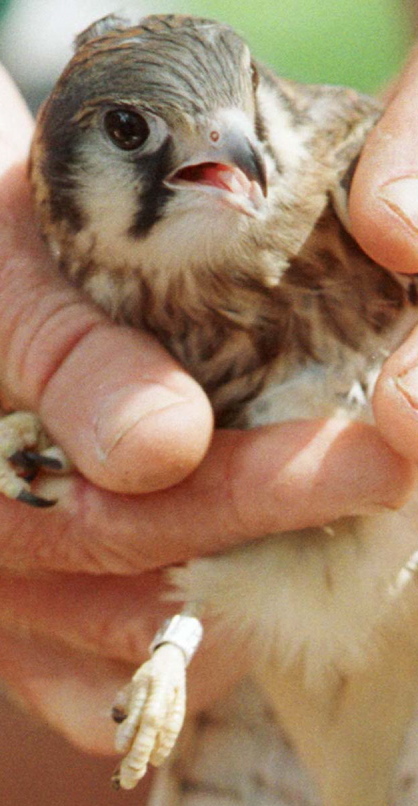An annual spring hawk count that begins Saturday at Bradbury Mountain in Pownal will be watched closely by biologists concerned about fluctuations in raptor populations, particularly the American kestrel.
The Bradbury Mountain Hawkwatch, entering its seventh year, is the only spring hawk count in Maine and is among a small percentage of counts in North America that take place in the spring rather than fall, based on a database of about 300 annual counts at hawkcount.org.
Biologists will be monitoring Maine’s count to see if it reflects recent trends in New York state, where biologists have seen a decline in the American kestrel population. In the Bradbury Mountain count, kestrel sightings dropped almost 40 percent from 2010 to 2011 – from 450 to 277 – and failed to rebound in 2012, although the count spiked back up to 432 last year.
“One thing going on across the Northeast is the American kestral, which is one species showing a decline, especially in their northeastern population,” said Daena Ford, the co-director at the Braddock Bay Raptor Research facility on Lake Ontario in New York, a spring count site for almost 30 years.
Ford said spring hawk counts are only one way to signal a decline in raptor populations, but they’re important because they show how many birds were able to survive the winter.
A hawk count is a survey in which qualified volunteers or paid birders count raptors passing by a specific site over a set period of time at the same time each year. The Bradbury Mountain spring count runs daily from 9 a.m. to 5 p.m. through May 15.
Most hawk counts across North America are done in the fall, when many more birds can be counted after the breeding season.
Because the Bradbury count is the only one in Maine held in the spring, it can be an important indicator of the health of Maine’s raptor population, said Derek Lovitch, co-owner of the Freeport Wild Bird Supply store, which sponsors the count.
In addition to the American kestrel, there have also been big fluctuations in the population of sharp-shinned hawks, Lovitch said. Sightings of this bird at Bradbury fell from 724 in 2010 to 370 in 2001, then climbed back to 589 in 2012 and 798 in 2013.
“The counts are very valuable to detect trends in populations,” said Maine state raptor specialist Erynn Call. “The spring count is valuable in that it includes a bit more because it includes the yearling birds in the spring, those that survived the winter. Something we want to do is work toward more hawk migration stations (in Maine), so we can better speak to the trends.”
Call said if, after another three years, the Bradbury count’s 10 years worth of data shows a serious decline – 50 percent fewer birds in any one species over that period – it could trigger the state’s process of evaluating a species for listing on the endangered or threatened species list. At that point, state biologists would gather more information on breeding populations and habitat.
“The birds that survived the winter are now part of the gene pool. Once they survived that first winter, they’re likely to reproduce. Those raw numbers have a little bit more meaning,” Lovitch said.
Bradbury Mountain, with a summit at 485 feet, offers a clear view of the spring migration of hawks returning to Maine. Not surprisingly, the hawk count site is a popular gathering spot for birders and raptor fans who can get a good view of birds such as bald eagles, ospreys and broad-winged hawks.
Data over the past six years has confirmed that the busiest two weeks to see raptors returning to Maine are the last two weeks in April.
“Our argument for holding (a spring count) is much more about the outreach and education. We don’t hire a scientist who counts birds, we hire an interpretive naturalist, someone who interacts with people and talks about birds,” Lovitch said.
“It’s amazing how many people who aren’t birders have not seen a bald eagle. They’re not rare in Maine, and people are just shocked when they see them. It’s unbelievable the lack of awareness of the natural world simply because people have never been told to look up.”
Most hawk counts occur in the fall because there are fewer birds and because it can be harder to find willing volunteers in the spring, when weather is often colder and wetter than it is in the fall, Lovitch said.
“It’s not as sexy to have small numbers,” Lovitch said.
Staff Writer Deirdre Fleming can be reached at 791-6452 or at:
Dfleming@pressherald.com
Twitter: @FlemingPph
Send questions/comments to the editors.



